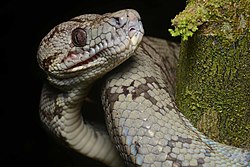| Corallus Temporal range: Paleocene to recent | |
|---|---|
 | |
| Amazon tree boa, C. hortulanus | |
| Scientific classification | |
| Domain: | Eukaryota |
| Kingdom: | Animalia |
| Phylum: | Chordata |
| Class: | Reptilia |
| Order: | Squamata |
| Suborder: | Serpentes |
| Family: | Boidae |
| Subfamily: | Boinae |
| Genus: | Corallus Daudin, 1803 [1] |
| Type species | |
| Corallus obtusirostris Daudin, 1803 | |
| Synonyms [2] | |
| |
Corallus, the neotropical tree boas, [3] are a genus of boas found in Central America, South America and the West Indies. Nine extant species are recognized as of 2017 [update] . [3]








